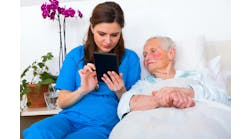In-home health evaluations offer the potential to reveal much greater detail and context to clinicians than shorter annual wellness visits in clinics. In a recent interview with Healthcare Innovation, Marc Rothman, M.D., chief medical officer at Signify Health, spoke about some of the benefits he has seen as his organization partners with Medicare Advantage plans to provide in-home evaluations to thousands of members.
Rothman has served as chief medical officer of Signify Health since June 2020. Previously he served as deputy chief medical officer at Aspire Healthcare, where he led a nationwide palliative care medical practice. He also served as enterprise chief medical officer at Kindred Healthcare, where he oversaw medical affairs, clinical quality, patient experience and pharmacy services.
Signify Health has a national network of approximately 9,000 licensed practitioners —physicians, nurse practitioners and physician assistants. On any given day, about 3,000 of them are making home visits.
Rothman sees the in-home assessments that Signify Health conducts are part of a larger trend of trying to deliver more care to patients in the home. “So much of American medicine has revolved around hospitals and clinics, where the physicians and nurse practitioners have traditionally been, but there is a real need to move to lower-cost settings to increase the convenience factor for the American consumer,” he said. Plus, there's so much innovation around remote technologies and remote diagnostics, and the pandemic accelerated that transformation from a telehealth perspective, he added, but there also is a movement to train the workforce to be savvy with visiting people in the home looking for problems, and trying to blend the social concerns with the clinical concerns.
“As a geriatrician, that speaks to me, because I'm used to treating Alzheimer's patients who have caregivers who are struggling and feel isolated, and not necessarily caring for themselves,” he said. “It is incredible what you can discern about a patient's actual healthcare situation by seeing them in their home environment as compared to the 20-minute visit at the clinic. There's no comparison really.”
Annual wellness visits in a clinic are valuable for gathering data about people’s health and for recommending appropriate health screenings, Rothman said. “But it's only really in a longer interview that you can sit down and talk about the importance of that, and that you can guarantee that it gets done. Because those recommendations often fall on deaf ears, and patients are busy. They're concerned about the potential cost of some of those tests. Or they're scared of procedures or testing in general. Sometimes they just don't want to know bad news.”
The in-home visit allows the clinician to better focus on a much more holistic picture, and talk about things like smoking cessation, advanced directives, which take more conversational time than just a routine clinic visit, he believes.
These visits take quite a bit longer than an office visit, Rothman stressed. “Our average is somewhere just shy of an hour. That's at least two to three times longer than the average visit in America today. When you think about persons over 65, who are often facing multiple chronic diseases, that's a long list to get through before you get to the preventive stuff, the smoking cessation, the advanced directives, the fall risk. The short visits are really just not enough to get that comprehensive view, in my opinion. And that's part of the reason you don't see a lot of geriatricians for example, succeeding in opening up offices on Main Street and hanging out a shingle for primary care. You can't do the work effectively with back-to-back 15-minute visits for that population.”
He says when it comes to issues such as fall risk or medication complexity, you have to see it to believe it. When you ask people in the clinic how they are doing at home or if they are having problems getting up or down the stairs, they generally nod and say yes. Yet a home visit may reveal something else entirely. Rothman recalled a home visit where the person lived in a split-level house and was using a walker. “It became clear that this person was only living in a portion of their home. They just couldn't get to other levels on a daily basis,” he said, “and if they did, the fall risk was through the roof.”
On the same visit, he asked the person to give him not just their medication list and what's in their pillbox, but also to show what medications are in the house, which means all those extra ones in the cabinet in the kitchen, in the bathroom, and at the bedside table. “We took all those medications and put them on the dining room table, which was circular, and it was like a mountain of medications,” Rothman said. “That really teaches you about how confusing medication management is for people with chronic diseases, and how expensive it likely is for them to have acquired all these and not utilized all of them. And it shows you how much medication goes to waste, because patients don't always take all the medicines.”
The in-home evaluations are a covered benefit at no extra cost to Medicare Advantage members that Signify helps serve. Medicare Advantage is a value-based program to some degree, and CMS finds this data valuable for risk adjustment, Rothman explained. “They have to know the risk of that population on an annual basis, so that they can adjust their rates that they contract with Medicare Advantage plans to care for that population. Our assessments capture over 200 pieces of data for them on an annual basis, which goes a long way for them to risk-adjust the Medicare Advantage population appropriately.”
In addition to its national network of clinicians, Signify Health also has a workforce of social care coordinators, who seek to close social determinant of health gaps that they find, Rothman said. “We do that with several plans nationwide, referring people to community-based organizations where we see food insecurity, housing insecurity, or inability to secure medications,” he explained.
“We find that lots of patients are skipping medicines, because they are unable to afford them, so there are prescription assistance programs we can connect them with. I think we made nearly 400,000, community-based organization referrals last year. Nearly a third of the people we see have been struggling with social isolation, about 15 to 20 percent have a transportation need —they can't actually get back to their PCP or to their specialist, or perhaps even to the drugstore to pick up their medicines, and about 35 percent have food insecurity,” Rothman said. “We also staff a fairly sizable workforce of nurse practitioners who do transitional care work between hospital and home on behalf of Medicare patients who are in value-based purchasing programs. That's an exciting program we've stood up this year, which has now touched over 5,000 patients in over 12 states, trying to reduce rehospitalizations. We do some work directly with dual-eligible patients in nursing homes as well.”
I asked Rothman how Signify shares information with the person's primary care physician to keep that provider in the loop and whether there were any health IT interoperability issues there.
“All of the discrete data elements go back to the Medicare Advantage plan, of course, since it is their member, and then any findings or diagnosis we uncover, and any recommendations we might have about the care of that patient go back to the PCP in the weeks after the visit,” he said. “They tend to get these mostly by fax because interoperability for PCPs in America has not been solved. We have been very successful in booking additional appointments back into physician offices, so we're trying to close that loop, and then eventually solve the interoperability problem. But it is a challenge, for sure. Also, one in 10 of the members that we see actually don't have an identified PCP or can't name their PCP, so we really push hard to get them connected with local providers in their community where we can.”
Next, I asked him if it would make sense for payers in other commercial spaces where they've got value-based arrangements to consider doing more of these in-home evaluation visits.
I believe so,” he said, especially for sicker populations within the commercial book of business. He mentioned patients with cancer or on dialysis, or with liver failure. “We're seeing a lot of in-home services start to be delivered as a nationwide trend. Some of the commercial payers are starting to develop reimbursement programs for their physicians to do some of that work. What I have generally found is that the PCPs and specialists who care mostly for commercial patients struggle to incorporate things like home visits into their practices. It's time-consuming. It's logistically complex. The interoperability and EMR challenges with a mobile workforce going out into the community are a big issue,” he added. “You think about the big incumbents in the EMR space — they're really not designed for a mobile work force. We are doing pilots with some of the commercial plan providers doing value-based care programs. We're engaged with their practitioners to see if we can leverage some of our technology and our workforce to meet people where they are — at home.”
Could this have implications for training the clinical workforce of the future?
Rothman said the trend of physicians looking for alternative settings to practice has been around for about five or 10 years. “I saw a trickle of it when I was training interns and residents and medical students and have them shadow me in the nursing home, for example. What has thrown a wrench into some of that, especially from the physician perspective, is that telemedicine provides them the opportunity to do lots of visits and do them from home, so they feel like they're inside the person's home via video, but they're not actually,” he said. “It is unclear whether telemedicine will sort of cannibalize this urge for physicians to get out into the community or not. I don't really have an answer for that.”
He said he has always tried to train the next generation to think about alternative sites of care, because then you get a very holistic view of what patients are dealing with, how they battle their diseases, and how that battle happens outside the clinic. “Physicians like to think that we're there for the entire disease, but we're not. We're seeing patients very intermittently for very short periods of time,” Rothman said. “The reality is that the patients and their families and their caregivers are battling disease, using their support systems, their resources, and their grit. Seeing that live as a physician is incredibly gratifying. And I do think that for younger physicians who are yearning for greater connectivity with patients, practicing in the home, getting out into the community, provides a really wonderful opportunity to do that.”


